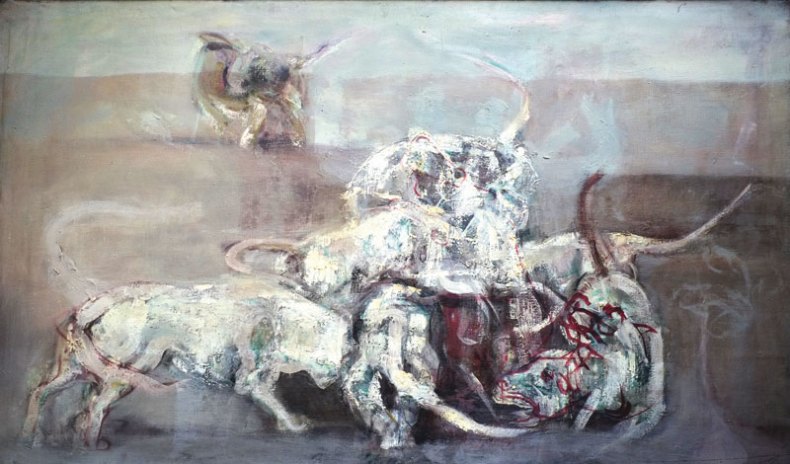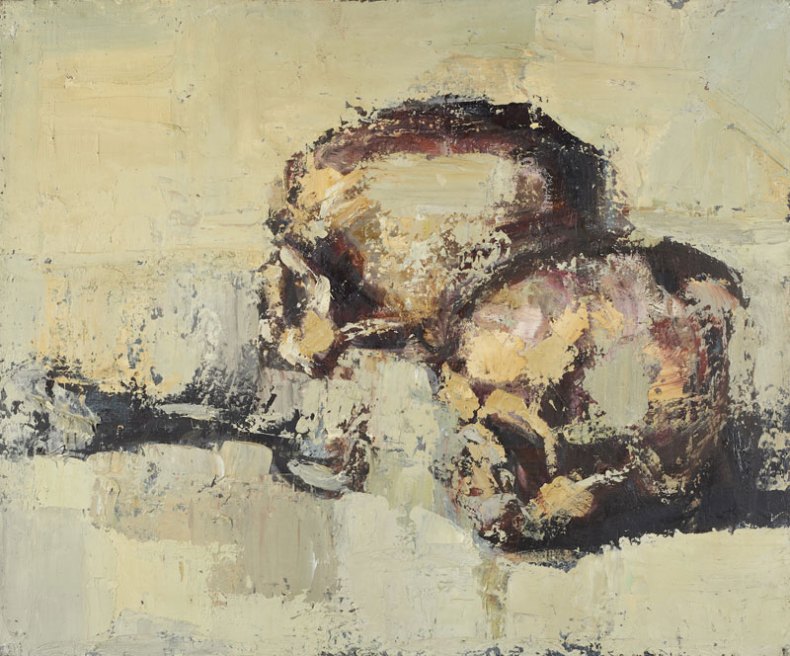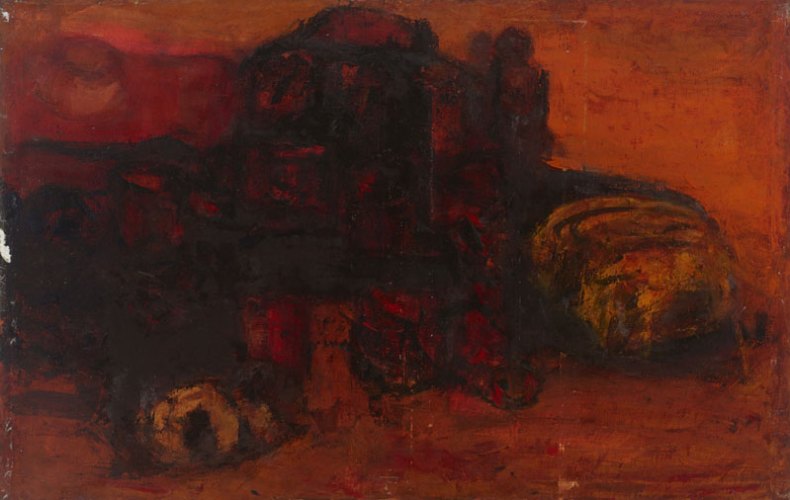A pack of blood-crazed dogs collides into a scrum, jostling for dominance as they rip into each others’ flesh. A pair of human skulls dry out in the heat, scraps of rotting flesh still just perceptible on their crania. The paint is thick and close, the palette – of reds like Spanish ham left out to fester, gangrenous yellows and faecal brown – almost stinks of advanced putrefaction. Their visceral evocation of decay will make your stomach churn, but these paintings are dramatic, grand and extremely arresting. It’s rare to chance upon an uncelebrated painting that feels vital, as though it absolutely had to be made – but a recent show at London’s Hoxton Gallery was packed with them. Not a single one had been seen in public in almost 70 years.
This is the work of the late artist and designer Keith Cunningham, an exceptionally promising painter on the periphery of the London Group, who for reasons nobody fully understands, abandoned painting as a career at the peak of his powers, subsequently becoming a successful designer and refusing all offers to exhibit. A contemporary and acquaintance of Frank Auerbach, Joe Tilson and Leon Kossoff, Cunningham worked at a time when British painting was arguably at its 20th-century zenith – and held his own up very respectably indeed. The question is obvious: why on earth did he walk away from it?

Fighting Dogs (c. 1956–60), Keith Cunningham
Before we can address this, it’s worth taking in some background information. Cunningham was born in Sydney in 1929, and after leaving school at the age of 15, went straight into working in the art department of the David Jones department store. He read widely around the subject of design – the Bauhaus was a particular touchstone – but also harboured ambitions to become a painter. At the age of 20, he travelled to London, where he was accepted to study in the Graphics department at the Central School of Art and Design.
Having worked in the fast-paced design world, Cunningham initially found the pace of art school tedious. ‘He couldn’t believe that [students] could be given three weeks to deliver something that he’d been used to having to turn out quickly as a professional,’ says his widow Bobby Hillson, then a young fashion student, who met him while he was assisting his mentor Gordon Andrews on a (sadly lost) series of giant murals for the Festival of Britain. But the comparatively slack pace of his course pushed him towards disciplines outside of his department, making use of everything the college had to offer.
‘I remember he said “come and see what I’m doing”, and dragged me into the sculpture school to see some heads he’d done,’ says Hillson. ‘He was using the school as I suppose he thought it should be used. He was off making furniture with Terence Conran at the weekends – welded furniture – and I was terribly impressed. To do all this, even then… it seemed he was so interested in everything.’

Skulls No.5 (c. 1954–60), Keith Cunningham
In 1952, Cunningham was accepted onto the fine art course at the Royal College after presenting a few works on paper to Rodrigo Moynihan, then the institution’s head of painting. His contemporaries at the college included a young Auerbach, who went on record recalling him as a particularly distinguished student – albeit one who preferred to keep his work to himself. Rather than using models, Cunningham would apparently look at the sitters in life drawing classes for a few minutes before rushing back to the small room he worked in to paint them from memory. Despite Cunningham’s unorthodox technique, Auerbach remembers his results – when at last he presented them – as ‘very distinguished […] full of nervous life.’ John Minton, who taught him at the RCA, remembered Cunningham as one of the most gifted students he encountered in his time there.
Hillson suggests that for a young man coming from Australia in the 1950s, access to the astonishing collections of European museums was awe inspiring, and after graduating from the Royal College with a first, he was awarded a grant to travel in Spain and a continuation scholarship. Hillson – then working at Vogue – was unable to join him on the adventure, but recalls how seeing Goya’s masterpieces first hand seeped into his work. ‘I don’t think there was ever a conscious influence from anyone,’ she says. ‘But unconscious influence, certainly. When you see the whole lot of paintings, there was something very Spanish about it.’

Head No. 6 (c. 1954–60), Keith Cunningham
Hillson says that people often – mistakenly – assume Cunningham had links to David Bomberg and the Borough Group, and you can see why. With their mud-thick textures and semi-abstract forms, his paintings of the period aren’t a million miles from what Auerbach and Leon Kossoff were doing, but the dark grandeur of that Iberian inflected palette lends his style an altogether more romantic character. It didn’t go unnoticed: Cunningham had paintings accepted to the Royal Academy’s Summer Exhibition, and had work included in a group show at Beaux Arts, before twice exhibiting with the London Group, where his work was singled out for praise by a critic from the Times.
But in 1960, when the group invited him to become a full member, he declined. Not long after, Cunningham retreated from the art world entirely, and never explained why – not even to Hillson. ‘He just didn’t want to talk about things that really mattered to him’, she says.
Did he feel, perhaps, that he’d said all he had to say as a painter? ‘No, I don’t think so,’ says Hillson. Indeed, if anything, it seems to have been more a question of practicalities than anything else. ‘I think he always thought he’d get back to it, but I don’t think he ever had the space.’ He had almost single-handedly constructed a studio in an old chapel near to the couple’s home in Battersea, but when he was forced to leave it, he gave up painting in oils for good.

Still Life No. 1 (c. 1954–60), Keith Cunningham
Survival may have been a contributing factor, too. Then as now, professional artists struggled to make a living, and both Cunningham and Hillson (who later established the fashion MA at Saint Martin’s) were not in a financially comfortable situation. ‘He’d sell the odd painting, but really he was just getting started,’ says Hillson. ‘He didn’t have the big studio, and this was basically it – he didn’t have the money to get the canvas or the paint.’
Cunningham returned to graphics, becoming a successful and widely respected designer, while also teaching at the London College of Printing. Nevertheless, he continued to keep up to speed with art world developments, from the work of his contemporaries to the YBA phenomenon of the 1990s, and continued drawing in private – accepting less than 20 studio visits before his death in 2014. ‘He wasn’t a sort of recluse,’ Hillson remembers. ‘But as [his former LCP pupil John Hegarty] says, he was very “contained” – very much in control of what he was doing.’
What, then, would he have made of his work’s posthumous reappraisal? ‘I know in a way that he’d want me to be doing what I’m doing – not that I think he’s floating above me or anything,’ Hillson tells me. ‘I just know the work is good enough […] you just can’t dismiss it, somehow’. Looking at these paintings today, her words feel like something of an understatement. And after the success of Auerbach’s Tate Britain show last year, one honestly wonders whether the national collection might not agree.

Still Life No. 2 (c. 1954–60), Keith Cunningham
‘Keith Cunningham: Unseen Paintings 1954–1960’ was at the Hoxton Gallery, London, from 30 September–13 October 2016. Works can be viewed at the gallery by appointment: contact Stephen Rothholz to arrange a visit (07951219931).














![Masterpiece [Re]discovery 2022. Photo: Ben Fisher Photography, courtesy of Masterpiece London](http://zephr.apollo-magazine.com/wp-content/uploads/2022/07/MPL2022_4263.jpg)
‘Like landscape, his objects seem to breathe’: Gordon Baldwin (1932–2025)